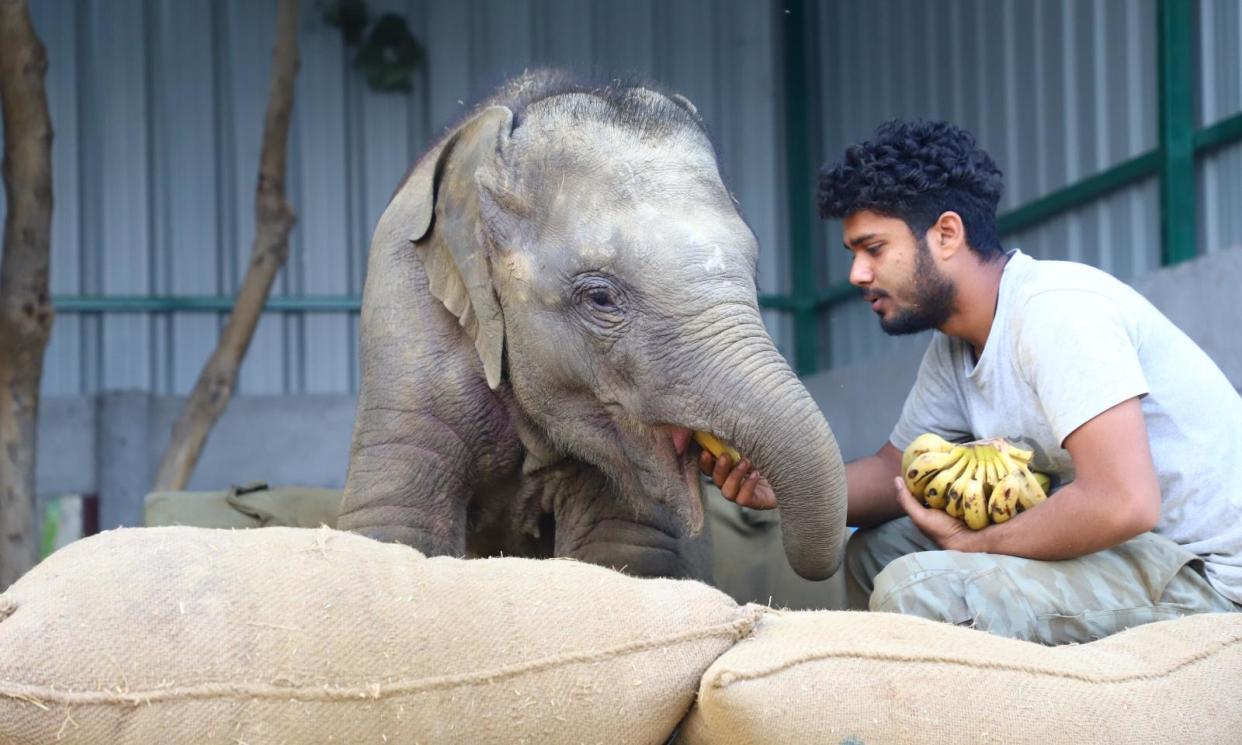Why are so many of India’s elephants being hit by trains?

Lying on a mound of soft sand inside the nursery, Bani looks like a spoilt child being indulged. Two members of the care team massage her hind leg with oil while the third, sitting at her head, funnels sticks of sugar cane gently into her mouth, clucking reassuringly.
It’s the royal treatment – but Bani, a nine-month-old elephant calf, needs all the medical care and nurturing she can get.
Bani was orphaned in mid-December when she and her pregnant mother were crossing a railway track near Jim Corbett national park in Haldwani. A speeding train smashed into them, killing her mother and flinging baby Bani into a ditch, leaving her with serious injuries and fractured bones.
For several weeks, the frightened calf, unable to stand, was treated locally. When the local forest department caring for her saw no progress, they contacted NGO Wildlife SOS, who sent a team of experts to provide critical care. Once she was strong enough, they transported Bani in a custom elephant ambulance to the Mathura hospital – India’s first specialist elephant hospital.
Since arriving, her life has been an intensive schedule of laser treatment, physiotherapy, hydrotherapy, nerve stimulation and ayurvedic massage. One day, she was able to twitch her tail, to the elation of the staff – it indicated her spine would recover. Then, with the help of a padded harness, she was able to stand for a few minutes, which was a “euphoric moment”, says Kartick Satyanarayan of Wildlife SOS.
“Bani may have to live her life with a handicap but with each day, you can see her becoming less scared and more playful. She loves her bananas and is quite a drama queen, [having tantrums] if she doesn’t get them,” says Satyanarayan.
Bani is the hospital’s first wild elephant and her arrival illustrates the growing threat posed by trains as railway lines cut through forested habitat and migration corridors. Satyanarayan says the Indian Railways’ primary consideration is cost when planning routes, not the need to protect elephants as they forage for food and water.
In India, death from train collisions is the second-highest cause of unnatural elephant deaths, after accidental electrocution. Official data shows that more than 200 elephants were killed in train collisions in the past 10 years. “There’s blood on the tracks when railway lines go through forest areas,” Satyanarayan says.
Indian elephants are classed as endangered, with numbers declining: about 40-50,000 remained in the wild globally at the last assessment in 2019. More than half of the species’ total range has disappeared or been highly fragmented by human settlements, roads and farms. The Wildlife SOS elephant conservation and care centre is a sanctuary for rescued elephants, many of which have come from circuses, hotels, wedding businesses or temples.
Shivam Rai, head coordinator at Wildlife SOS, says most of the 36 elephants in their care have experienced violence at the hands of humans. A number are blind. Many have severe physical disabilities.
“Giving them comfort and dignity is our way of saying sorry – sorry we did this to you, sorry we snatched you from the wild and took you away from your family, sorry for taking everything from you,” says Rai.
AI systems and strict speed controls will save hundreds of elephants
Kartick Satyanarayan
The increasing number of elephants being killed by trains has led to calls for changes to the way the railways are managed. Last year, Tamil Nadu in south India installed an AI-enabled surveillance system to monitor elephant movement near railway tracks to help prevent accidents. Sensors pick up elephant movement and alert train drivers, station staff and line controllers.
In other areas, the railways are being fitted with similar systems that sense vibrations, detecting the presence of elephants with nearly 100% accuracy. A system installed in north-east India triggers more than 40 alerts a day.
Flyovers covered with foliage are another option to provide a safe passage for wildlife. In West Bengal, a flyover lined with bamboo and banana trees has been built to encourage elephants to use it and cross the track safely.
But rolling out safety measures is a huge challenge. Indian Railways spans 130,000km (81,000 miles) of track and the country has 150 elephant corridors.
Wildlife SOS believes that if an AI early warning system had been in place, Bani’s mother would be alive and Bani would not be disabled.
“The forest is their home and the trains are invading their homes. Urgent installation of AI-enabled accident prevention systems and strict implementation of speed controls will save hundreds of elephants,” says Satyanarayan.
Related: Animal crossings: the ecoducts helping wildlife navigate busy roads across the world
Of the animals that are hit, Bani is one of the lucky ones. Her progress is steady but slow. Her appetite is gradually improving and she is now able to hold herself up for short periods of time. For the staff who work with her, her recovery is tinged with sadness.
“Bani may never be a normal elephant and can never be wild again,” says Satyanarayan. “She will live with a handicap all her life. Our hope is that she recovers enough to live a life of dignity and freedom.”
Find more age of extinction coverage here, and follow biodiversity reporters Phoebe Weston and Patrick Greenfield on X for all the latest news and features


